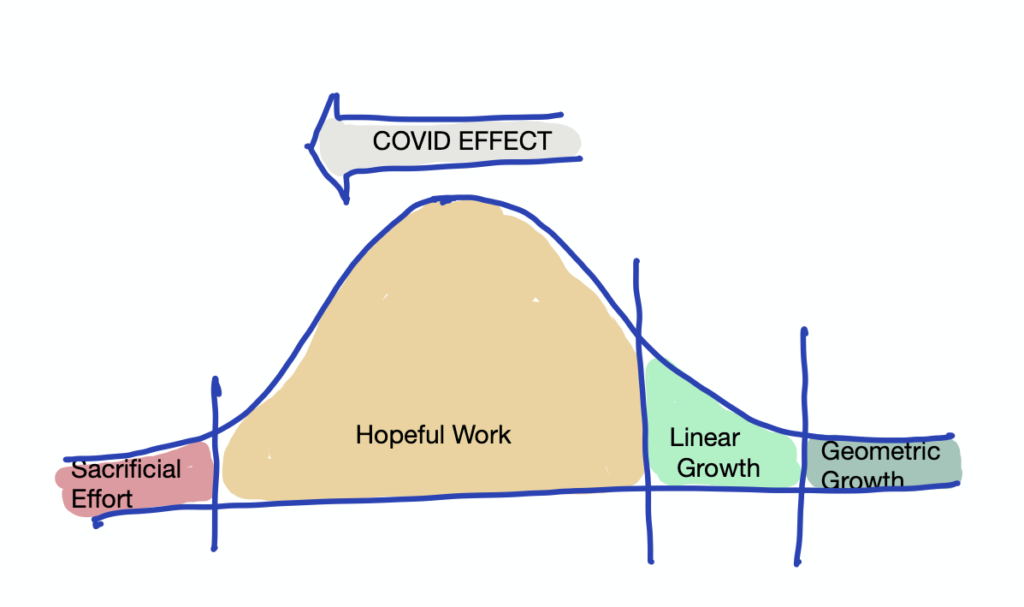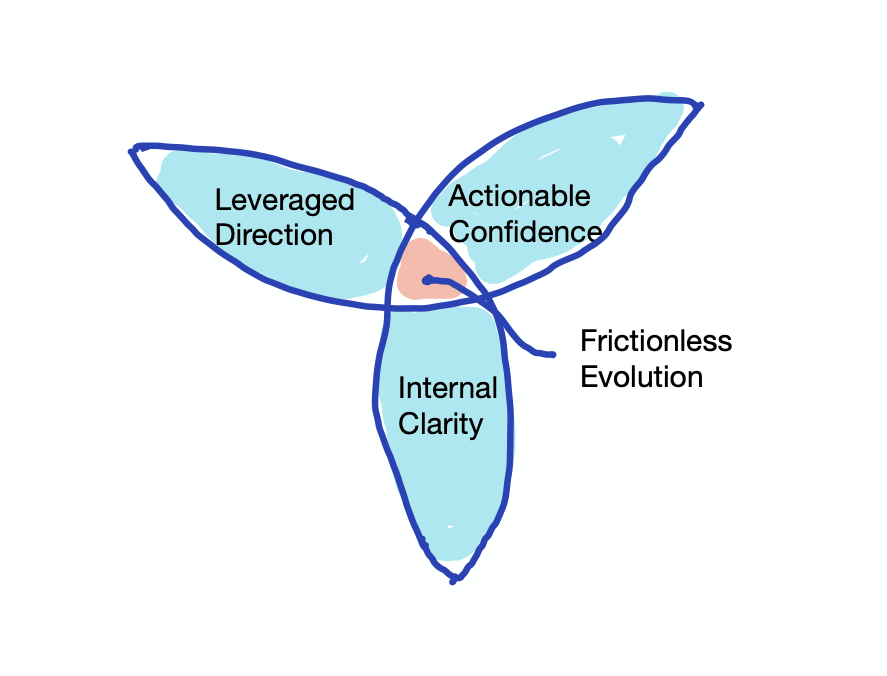
I’ve had a number of recent calls with strategic and operational leaders from larger firms with matrixed organizations. They are primarily in manufacturing industries ranging from food to water treatment. Each has had their own journey meeting their customers and clients’ rapidly changing demands during the pandemic.
They are similar in one regard: COVID has pushed them backward in their ability to execute their strategic agenda. The push into less efficient execution has created an increased load on already busy leaders, and in some cases, has moved them into unsustainability. Most importantly, there is consensus that firms will not “snap back” to “normal”, and there will be a need to step up to refashion strategic implementation in light of our new way of working in 2021.
Capturing the Shift
To enable a discussion of these universal patterns and experiences, I share a four-zone bell curve model that allows a rapid self-identification of the quality and efficiency of strategy execution. The lowest zone is called “sacrificial effort” and is the zone where individuals, largely unassisted by their peers, processes, and leaders, have taken the individual initiative to put the strategy into action. This is an unsustainable zone and will burn out those who are trying to get the new strategy into place.
One layer up, we have a zone I call “hopeful work.” This is where a group recognizes that there is a formula and is interacting at the task and transactional level. Decision-making is challenging with outcomes questioned and sometimes completely reversed. Momentum is short-lived, review meetings are lengthy and “restarts” are frequent.
Third, we have “linear progress,” where typically one or two teams are killing it, and decision making has firmed up, however, implementation of those decisions is often incomplete. The breadth of leadership is also thin, with one or two people carrying the majority of the effort. With the narrowness of momentum and dependence on personal leadership, the group is one resignation away from dropping into hopeful work or sacrificial effort.
Finally, we have “geometric growth” where implementation is integrated vertically and horizontally in the org, and high-stakes decisions are executed well. People, processes, and platforms are coming together to serve emerging demand in fresh and powerful ways. Perhaps most importantly, the momentum of a project is resilient and shared, and leaders are freed up to do the important work of looking ahead to emerging opportunities.
In my discussions with firms, the consensus is that COVID has pushed them at least one step to the left. This means that each firm is consuming significantly more energy in executing strategies than prior to the pandemic. Drifting back to “normal” is not an option, as the experience of working during the pandemic has permanently changed us. Recovering from this will not be automatic, and firms are finding that it takes clear-eyed diagnosis, focus, and investment to get back on the road of efficient strategic execution.
Time in this case is not a friend, and many firms will find that distraction and friction will move them away from efficiency, leading to stress, frustration and burnout.
The good news is that with focused work, firms can build a path that not only gets to “normal”, but can lead them to new levels of performance, i.e. one or two steps to the right. The challenge is to think at a different level that allows precious talent to gain leverage on this critical work.
I Know Where I Am, What do I Need to Focus on?

When approaching uncharted territory, it’s important to have a shortlist of patterns and principles in hand to safely guide you through the discovery process and allow you to build a fresh and better process, product, or service.
In my work with teams challenged to drive innovation in their firm, we’ve found three vectors that provide strong leverage for moving the group back upstream:
- The first need is to assess the quality of a group’s leveraged direction. This vector measures the strength of the insight underlying a given project and the ability to take concrete action towards achieving it. By looking carefully at the project and the approach, we are able to understand the richness of the opportunity and the quality of the plan towards obtaining it.
- Secondly, the group needs to assess its level of actionable confidence. This vector measures the presence of a solution and an equipped team to complete implementation. The key to assessing the health of this need is to look at how the team is forming and executing decisions. If you find analysis paralysis or frequent second-guessing and reversals, it’s a sure bet that the group is struggling with putting vision into action.
- Finally, the last key vector is to measure internal clarity. This attribute is specific to the group at large and is quickly gauged by assessing the ability of leaders and team members to be on the same page, at any location, time zone, or function in the firm. Best-in-class actors have done the alignment work, not only with core team members, but the support teams as well to assure that there is end-to-end alignment. At the higher levels, these teams find a deep sense of internalized mission and self-accountability that create deep momentum.
By using a diagnostic, we are able to access health along these three vectors and develop clear and specific next steps.
Got it, Now How do I Get to The Next Level?
Each of the three areas described above has its own set of three focal point imperatives that will allow a team to plan the next step with confidence. The first action we do with teams is a diagnostic so they know precisely where they are on the framework, and which of the imperatives will have the highest leverage.
If you’d like to talk more about how this system could be put to work for you and can help break through the most difficult implementation projects, please reach out to me.
You can use this link to book an appointment directly, or email me at scott@scottpropp.com.
Related Posts:

